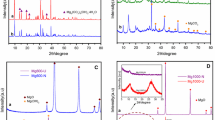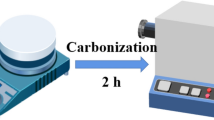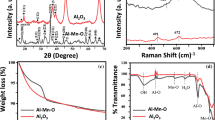Abstract
Uranium uptake from acidic solutions is comprised practically in this study into three main steps namely; adsorbent synthesis, uranium uptake procedure, and desorption step. In this respect, two uranium adsorbents were synthesized from mineral processing of ilmenite and talc. Titanium phosphate adsorbent (TP) was deposited from titanium sulfate solution obtained from ilmenite sands processing. On the other hand, magnesium silicate adsorbent (MS) is prepared by sodium metasilicate neutralization of the acidic magnesium bearing waste solution resulted from talc whitening process. Structurally and chemically the two adsorbents were investigated by XRD, IR and SEM-EDX analyses. The studied factors affecting the uranium uptake onto TP and MS adsorbents were uranium concentration (10–1000 ppm), acidic pH range (1–6), contact time, shaking time and solid to liquid ratio. The uranium analysis was determined spectrophotometrically using arsenazo(III) dye where SEM-EDX analysis confirmed the uranium uptake by adsorbents. The optimum conditions obtained were applied to uranium bearing, highly mineralized granite samples (5200 ppm U) and black shale (40 ppm U). The uranium uptake was more than 98% for the mineralized granite samples and more than 97% for shale. The loaded uranium was recycled by using 0.5 and 1M HNO3 in case of TP and MS with percentage recovery of 96 and 98% respectively.



Similar content being viewed by others
References
Sasaki Y, Tachimori S (2002) Extraction of actinides (III), (IV), (V), (VI) and lanthanides (III) by structurally tailored diamides. Solvent Extr Ion Exch 20:21–34
Gupta KK, Manchanda VK, Subramanian MS, Singh RK (2000) Solvent extraction studies on U(VI), Pu(IV) and fission products using N, N dihexyloctanamide. Solvent Extr Ion Exch 1:273–292
Yaftian MR, Taheri R, Zamani AA, Matt D (2004) Thermodynamics of the solvent extraction of thorium and europium nitrates by neutral phosphorylated ligands. J Radioanal Chem 262:455–459
Nash KL (1993) A review of the basic chemistry and recent developments in trivalent f-element separations. Solvent Extr Ion Exch 11:729
Schulz WW, Horwitz EP (1988) The TRUEX process and the management of liquid TRU waste. Sep Sci Technol 23:1191–1210
Siva Kesava Raju Ch, Subramanian MS (2005) DAPPA grafted polymer: an efficient solid phase extractant for U(VI), Th(IV) and La(III) from acidic waste streams and environmental samples. Talanta 67:81–89
Siva Kesava Raju Ch, Srinivasan S, Subramanian MS (2005) New multi-dentate ion-selective AXAD-16-MOPPA polymer for the preconcentration and sequential separation of U(VI), Th(IV) from rare earth matrix. Sep Sci Technol 40:2213–2230
Prabhakaran D, Subramanian MS (2004) Extraction of U(VI), Th(IV), and La(III) from acidic streams and geological samples using AXAD-16-POPDE polymer. Anal Bioanal Chem 380:578–585
Merdian M, Duz MZ, Hamamci C (2001) Sorption behavior of uranium(VI) with N, N-dibutyl-N-benzoylthiourea impregnated in Amberlite XAD-16. Talanta 16:639–645
Fritz JS (1999) Analytical solid phase extraction. Wiley-VCH, New York, p 39
Jain VK, Handa A, Sait SS, Shrivastav P, Agarval YK (2001) Preconcentration, separation and trace determination of lanthanum(III), cerium(III), thorium(IV) and uranium(VI) on polymer supported ovanillinsemicarbazone. Anal Chim Acta 429:237–246
Siva Kesava Raju Ch, Subramanian MS (2005) Selective preconcentration of U(VI) and Th(IV) in trace and macroscopic levels using malonamide grafted polymer from acidic matrices. Microchim Acta 150:297–304
Thakur P, Moore RC, Choppin GR (2005) Sorption of U(VI) species on hydroxyapatite. Radiochim Acta 93(7):385–391
Krepelova A, Sachs S, Bernhard G (2006) Uranium(VI) sorption onto kaolinite in the presence and absence of humic acid. Radiochim Acta 94(12):825–833
Rashed MN (2001) Lead removal from contaminated water using mineral adsorbents. Earth Environ Sci 21(3):187–195
González JC, Molina SM, Rodríguez-Reinoso F (2001) Sepiolite-based adsorbents as humidity controller. Appl Clay Sci 20(3):111–118
Erdaq S, Tolay M, Yucel SO, Turkay S (2007) Method of producing an adsorbent from rice hull ash, United States Patent No., 7279147
Yang H, Hu DC, Jin Y, Yang SW, Tang A, Avakumov EG (2006) Preparation of porous material from talc by mechanochemical treatment and subsequent leaching. Appl Clay Sci 31(3–4):290–297
Konstantinou M et al (2007) Adsorption of hexavalent uranium on dunite. Global NEST J 9(3):229–236
Lebedev VN, Mel’nik NA, Rudenko AV (2003) Sorption of cesium on titanium and zirconium phosphate, Radiochem 45(2):149–151
Marcezenko Z (1976) Spectrophotometric determination of elements, Halsted Press, a division of John Wiley & Sons Inc., New York, London, Sydney, Toronto
Bortun A, Strelko VV, Jaimez E, Garcia JR, Rodrigue J (1995) Synthesis of semicrystalline materials by organic compound interaction into amorphous titanium phosphate. Chem Mater 7(2):249–251
Gerasimova LG, Maslova MV, Zhdanova NM, Okhrimenko RF (2004) Composition of solid phases isolated from sulfuric acid solutions of titanium(IV) by the action of phosphoric acid. Russ J Appl Chem 77(6):896–900
Zhuravle I, Zakutevsky O, Psareva T, Kanibolotsky V, Strelko V, Taffet M, Gallios G (2002) Uranium sorption on amorphous titanium and zirconium phosphates modified by Al3+ or Fe3+ ions. J Radioanal Nucl Chem 254(1):85–89
De Oliveira SF, Airoldi C (1993) Some ion exchange properties of amorphous titanium (IV) phosphate. J Microchim Acta 110(1–3):95–101
Uryupina OY, Mikhailova SS, Serebryakova NV (1998) Adsorption properties of amorphous titanium phosphate. Colloid J Russ Acad Sci 60(3):383–387
Zhang O, Sugiyama K, Saito F (1997) Enhancement of acid extraction of magnesium and silicon from serpentine by mechanochemical treatment. Hydrometallurgy 45(3):323–331
Ciesielczyk F, Krysztafkiewicz A, Jesionowski T (2007) Adsorptive properties of synthetic magnesium silicates. Physicochem Probl Miner Process 41:185–193
Nesterchuk NI, Makarova TA (1970) The formation of aqueous magnesium silicate in the interaction of solutions of magnesium chloride and sodium metasilicate. Russ Chem Bull J 19(10):2053–2055
Zhuang Y, Yang Y, Xiang G, Wang X (2009) Magnesium silicate hollow nanostructures as highly efficient absorbents for toxic metal ions. J Phys Chem 113(24):10441–10445
Berw DRM, Glasser FP (2005) Synthesis and characterization of magnesium silicate hydrate gels. J Cem Concr Res 35(1):85–98
Jia K, Pan B, Zhang Q, Zhang W, Jiang P, Hong C (2008) J Colloid Interface Sci 318(2):160–166
Jesionowski T, Krysztafkiewicz A (2001) Influence of silane coupling agents on surface properties of precipitated silica. Appl Surface Sci 172:18–32
Author information
Authors and Affiliations
Corresponding author
Rights and permissions
About this article
Cite this article
Fouad, H.K., Bishay, A.F. Uranium uptake from acidic solutions using synthetic titanium and magnesium based adsorbents. J Radioanal Nucl Chem 283, 765–772 (2010). https://doi.org/10.1007/s10967-009-0435-6
Received:
Published:
Issue Date:
DOI: https://doi.org/10.1007/s10967-009-0435-6




